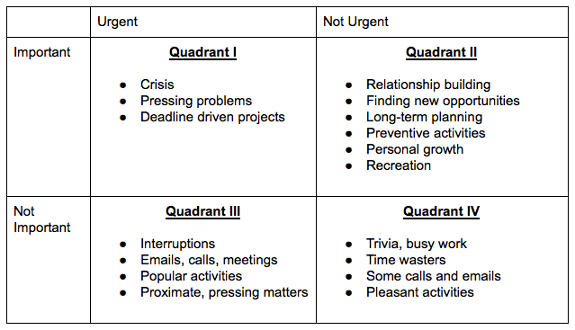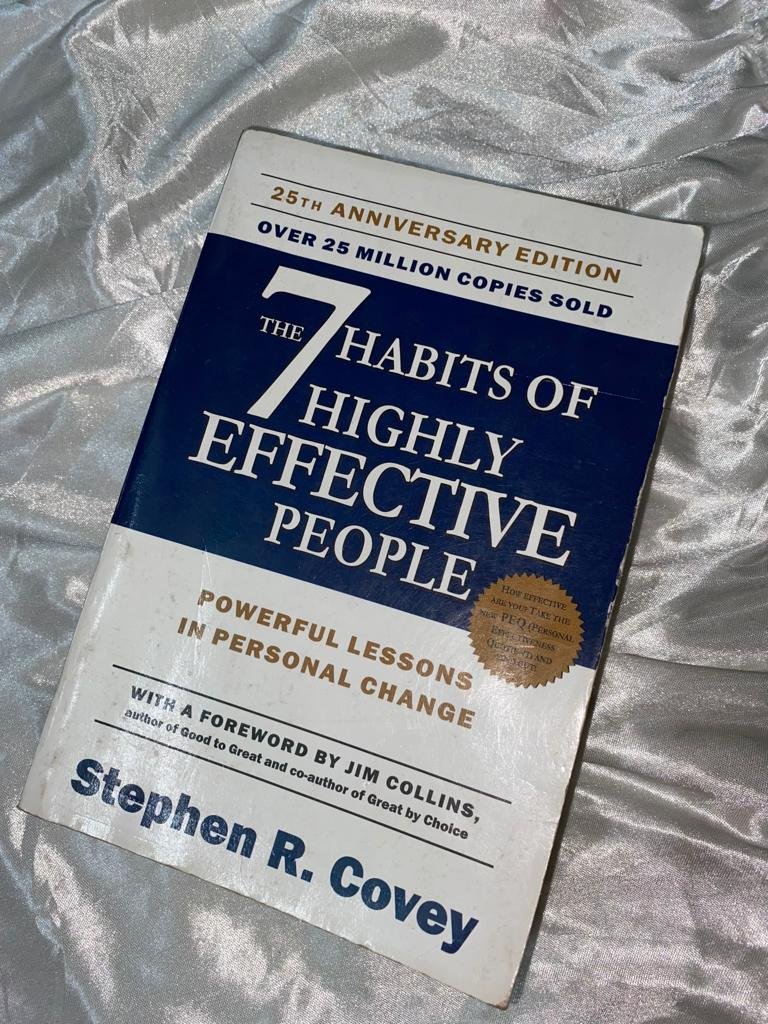Time management is an important concern today. With the human attention span shrinking to as low as 8 seconds, it has become difficult for people to focus. This has affected both concentration power and time management.
Recently, I wrote a blog about effective time management tips that anybody can implement in their lives. These tips are helpful for people wanting to gain back control of their lives. Today, I am taking those tips a step ahead by sharing a method I discovered recently in a marvelous book.
I have been reading “7 Habits of Highly Effective People” written by Time magazine’s 25 most influential Americans, Stephen R. Covey. The book was named the No.1 Most Influential Business Book of the 20th century.
I am a slow reader. I like to take my time to deeply understand the book. This is why it’s been over a month since I started this book and I am only halfway through it.
As the title speaks, the book is about powerful habits that bring strong changes. They create a significant impact on a person’s lifestyle. While all the habits are “effective”, the third habit specifically caught my attention. It associates with private victory: Put first things first.
The third habit teaches the nuances of prioritizing things in life with a time management matrix. It’s easy to follow and implement. Let’s more about it.
The easiest method of time management: Featuring 7 Habits of Highly Effective People
The author explains the importance of time management through its four generations. Let’s understand them better:
1. 1st generation
Here, the author highlights the era of time management with notes and checklists. The time when people use to handle the many demands of our time and energy manually, using paper and a pen. This is where it all began.
2. 2nd generation
The second generation of time management brings in calendars and appointment books. When designer books and calendars took charge to schedule events and activities beforehand.
3. 3rd generation
This is the system of time management that adds the idea of prioritization to the previous ideas. This includes daily planning to set short-term tasks for you to achieve long-term goals in the future. This generation focuses on everyday targets to achieve goals of the greatest worth.
4. 4th generation
The 3rd generation made people feel “too scheduled”. Thus, people are moving back to the 1st and 2nd generation methods of time management. They want to preserve relationships and spontaneity in their lives. They don’t want to lose the fun of living life. This has given rise to the 4th generation of time management. It says and I quote, “The challenge is not to manage time but to manage ourselves”. The focus has shifted from things and time to preserving relationships and accomplishing results.
The author captures the essence (of the 4th generation) of time management in life with a single phrase: Organize and execute around priorities.
To make the 4th generation ideas simpler he talks about a time management matrix that reflects how we can organize ourselves. He shares a simple system that can lead to effective time management with little, everyday effort.

The Time Management Matrix
The author explains that any activity is measured by two parameters: importance and urgency.
Urgency is visible. It’s in action. You can see when someone is doing something urgent. While urgent tasks must be done “now”, this doesn’t mean they are necessarily important. Importance is related to results. It’s something that contributes to the results. It includes fulfilling your mission, your vision, your values, and your high-priority goals.
Let’s talk more about the concept in the time management matrix:
1. Quadrant 1: Urgent and Important
- Activities: Any major crises, pressing problems, or deadline-driven projects.
- Results: Stress, Burnout, Crisis Management, Always putting out fires
The quadrant 1 activities are called “crises” or “problems”. These are urgent as they must be done now. And they are essential because they have some significant goals attached to them. It deals with results that require immediate attention and action. Focusing on quadrant 1 leads to the consumption of emotions. These activities get bigger with time and they begin to dominate you. Your life gets filled with tasks that are urgent and important. This leaves no room for creative thinking.
2. Quadrant 3: Urgent but not important
- Activities: Interruptions, some calls or emails or reports or meetings, pressing matters or popular activities
- Results: Short-term focus, Crisis Management, Reputation Chameleon character, Seeing goals and plans as worthless, Feeling victimized or out of control, Shallow or broken relationships
A good number of people spend most of their time in Quadrant 3 thinking they are in Quadrant 1. They spend time on activities that are urgent because they think they are also important. When in reality, the urgency of these activities is simply based on priorities and other people’s expectations and never on importance.
Spending time in Quadrant 3 simply makes a person irresponsible, just like in Quadrant 4.
3. Quadrant 4: Not urgent and not important
- Activities: Trivia, Busywork, Some mail or phone calls, Time wasters, or pleasant activities
- Results: Total irresponsibility, fired from jobs, dependent on others for even basic things
Spending time doing activities from quadrant 4 makes you irresponsible. The author says that effective people stay away from quadrant 4 because the urgency doesn’t matter. Urgency is secondary. The primary concern is important. And since quadrant 4 means neither urgent nor important, they are not worthy of your time.
4. Quadrant 2: Not Urgent but Important
- Activities: Prevention, Relationship building, Recognizing new opportunities, Planning, Recreation, Small targets focusing on long-term goals
- Results: Vision and perspective, balance, discipline, control, and lesser crisis
The 2nd quadrant is the heart of effective personal and time management. It deals with things that include working on small, everyday tasks to achieve bigger goals. People living in Quadrant 2 focus on building relationships to create opportunities. They devote their time to activities that demand short-term pain to yield long-term results in the future. While sticking to quadrant 2, you focus on activities like long-range planning, exercising, preventive maintenance, and preparation.
How to make more time for Quadrant 2?
Now you know that the easiest method of time management is to organize your life in a way that you spend most of your time doing the Quadrant 2 activities.

Stephen Covey paraphrases Peter Drucker in his book to simplify this for you.
“Effective people feed opportunities and starve problems. They think preventatively. They are not problem minded, they’re opportunity minded.”
Initially, you get time for quadrant 2 by cutting down your time from quadrants 1 and 3 and eventually replacing them with activities of quadrant 2. You cannot immediately corner the activities from Quadrant 1, although they will shrink in size as you spend more time in Quadrant 2 activities.
Quadrant 2 will demand you to be proactive and prioritize what’s important in the long run. To say ‘yes’ to quadrant 2, you will have to learn to say ‘no’ to activities in quadrants 1 and 3. You say ‘no’ to the unimportant when you have your purpose clear to yourself.
6 tools of Quadrant 4 in the time management matrix:
Quadrant 2 aims to manage your lives effectively. It doesn’t focus on time management. But, it teaches you what leads to effective time management: life management. As someone who wishes to improve the quality of their life by becoming a quadrant 2 person, you must possess these 6 important tools:
a. Coherence: Coherence means that there is harmony, unity, and integrity between your vision and mission, your roles and goals, your priorities and plans, and your desires and discipline.
b. Balance: Just because your purpose and profession drive you, that doesn’t mean you will neglect other areas of life. As a truly effective person, one must balance the different areas of life.
c. Focus: Quadrant 2 asks you to develop a tool that lets you build a preventative lifestyle instead of dealing with last-minute crises and moving toward Quadrant 1. Stephen Covey suggests that that tool should be improving your focus using weekly planning. Planning your life weekly gives you more space and context to adjust to the different roles that you play in your life. It’s been 8 weeks that I am doing it now. You can read about my weekly planning experience here.
d. A “People” Dimension: When creating your schedule, you must ensure that your life has a people dimension. This means you cannot be driven by your work and stay entangled in your professional development all the time. You must be effective in dealing with people and not just schedules. Rearranging your schedule shouldn’t ignite the feeling of guilt within you.
e. Flexibility: Your plans and schedules must be your slave, not your masters. Flexibility suggests that you don’t let your plans control your life.
f. Portability: Whatever it is that you use for sticking to quadrant 2, your tool must be portable. It should not become a barrier in your plans because of its size. You must be able to carry it any and everywhere you want.
Conclusion
If you take a closer look at your lifestyle and that of the people around you, you will find that most of us are lost in doing activities from quadrants 3 or 4. The ones that don’t yield any positive results for us.
As times have progressed, some of us have moved from physical planners to digital planners. Whatever it is that works for you, the results don’t lie in planning. They are determined by the actions you take.
Living a life that is driven by quadrant 2 of the time management matrix is the secret you need for effective life management.
When I read this part of the book, I was happy to read that out of all the things that are mentioned here, I have been practicing some of them for the longest time now.
It is incidents like these that ensure that I am doing something right with my life after all and it is not as chaotic as I think it to be.
I have shared my secret with you all, now it’s your turn.
So tell me, what’s the most effective time management practice you follow?
Take your time to reply in the comments.
I’ll see you again, the next week!




